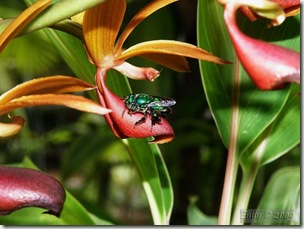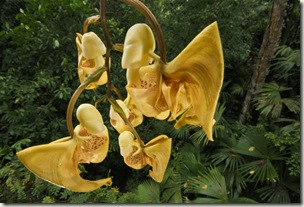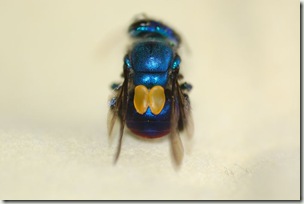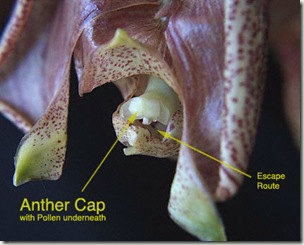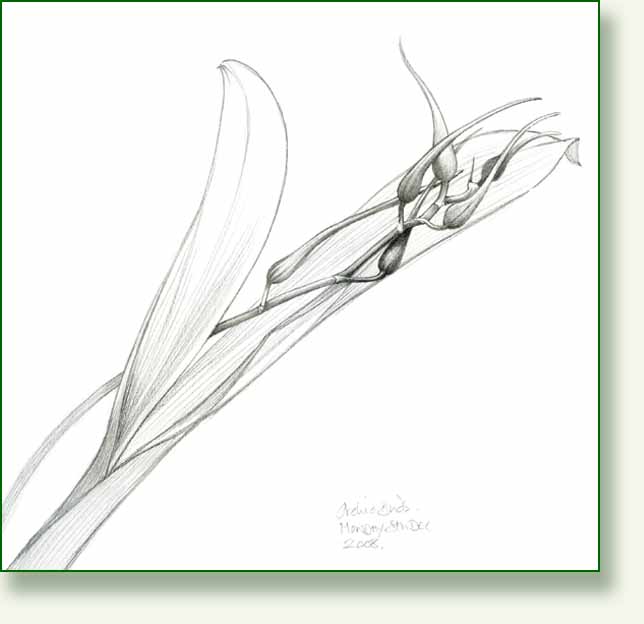Yesterdays Euglossa encounter was my first introduction to the extraordinary world of orchid bees. They are fascinating:
The facts
CLASS: Insecta
ORDER: Hymenoptera, Bees, wasps, ants and sawflies.
FAMILY: Apidae, Honey, Bumble and Digger bees
GENUS: Euglossa Orchid Bees
Long tongued, metallic coloured bees which are mainly found in New World tropical rainforests.
They are called Orchid Bees because they pollinate over 700 species of tropical orchids, and some orchids rely entirely on these little bees for pollination.
Mixing the right scent
In general it is only the males that pollinate the orchids, not because they are looking for nectar or pollen, but for scented substances which they mix together to create their own alluring perfume.
With little combs on their front feet they scrape the scented oils from the surface of the orchids and store them in handy pockets located in those big hind legs. The exact mix of fragrance seems to be quite crucial.
A well scented male Orchid Bee sends out just the right signal to the female, demonstrating that he is a good forager and a strapping healthy and long lived bee.
Get the mix wrong and you will be shunned. To understand more about this wonderful symbiotic relationship, watch this excellent film from Science Online. It explains so very well all about the orchid structures and the bees’ part in the pollination. Nice voice over too.
A one sided arrangement.
The orchids which rely exclusively on Euglossa bees for pollination are the Catasetinae and Stanhopeinae sub tribes of Orchidaceae, which include the well known Mormodes and Coryanthes or “bucket” orchids.
These orchids do not produce nectar and rely purely for their pollination on luring the male euglossa bees with their promise of top class perfume ingredients.
It seems however that the bees can manage just fine without them, and since Euglossa viridissima have been seen in South Florida since 2003, where these orchids do not naturally occur, researchers have realised that they don’t need the orchids as much as the orchids need them.
The bees are able to find the exact needed compounds from leaves and other sources. If you speak Spanish there is more interesting info and photos in Infojardin forum here.
One of many excellent photo’s from Candle in Panama in the discussion forum. Euglossa viridissima en Mormodes fractiflexa by Candle

Drowning for love A very complex pollination strategy has been developed by the bizarre Coryanthes or “bucket” Orchids, strange orchids which look too much like bits of internal human plumbing for my liking.
As I have said before I have never been quite sure about orchids, sometimes they are just too sinister. (Wikispecies has a good piece about them here )
Eric Hansen in his book “Orchid Fever” has a vivid description of what happens:
“The orchid secretes a powerful intoxicating perfume that the bee finds irresistible. At the same time, a specialized gland secretes a clear, colorless liquid that drips into the bottom of the bucket, forming a small reservoir.
Within minutes of the flower’s blooming, male bees in a state of great agitation swarm around the flower, near the bottom where the fluid-containing reservoir is located.
They hover, seeking a foothold on the slippery tubular part that connects the bucket to the rest of the flower. Grasping the slippery tubule with their legs, the excited bees “bathe” themselves in the waxy perfume.
Because the flowers bloom for only a few days, there is a mad rush among the bees to get at the limited amount of special scent. They shove and jostle at each other. Occasionally, a bee loses his footing on the slippery surface or gets knocked into the bucket when his wings collide with a droplet from the dripping gland.
Once inside the bucket, the unfortunate bee’s ordeal begins. There is only one exit – a narrow dark tunnel that leads through the front wall of the flower to daylight and freedom. There is no room to turn around, so the bee must wriggle and squeeze his way forward, stopping to rest many times.
Just before he reaches daylight, he passes beneath two paired masses of pollen attached to the roof of the tunnel. At that precise moment, the pollen disengages and attaches itself on the back of the bee between his wings like a small backpack.
This nightmarish experience may take as long as 40 minutes. Once the pollen has been collected, the flower has served its purpose. The scent vanishes and the flower quickly wilts.
Wet and disoriented, the bee pauses to dry himself. It maybe a day or more before perfume from a second bucket orchid will arouse the bee’s interest. On the bee’s visit through a second bucket orchid, a catch mechanism on the roof of the escape tunnel seizes the pollen backpack.
In this way, the bucket orchid is pollinated, and with luck a seedpod will form. Freed of his backpack and remembering his own procreation duties, the bee flies off to a display site where he conducts an exotic courtship dance.
He performs fancy footsteps as a heady scent of perfume wafts from his hind legs. With such captivating artistic display and alluring scent, what female bee could resist the temptation to land and get better acquainted?


2 Photos of many published by gole orckide from Persian Hub here showing the orchid Coryanthes panamensis.. and the bedraggled bee escaping through the trap door.
The writer also quotes;
“Smithsonian horticulturist Tom Mirenda says that to them, the flowers’ smell is as luscious as “five kinds of dessert baking at once.” “

And here photo by Candle from Infojardin again, a blue Euglossa bee, with the two pollinia firmly stuck to its back ..I
read that the plant will only allow the bee to escape after allowing time for the “glue” to dry.. Amazing..
See another full explanation and some very good diagrammatic photographs of the whole strange and wonderful process, (see below), from Troy Meyers’ Conservatory site, here.

You can learn how to pollinate your buckets if you are not a bee and all about the completely-new-to-me world of “Flasking”. I think I have some more reading to do.

